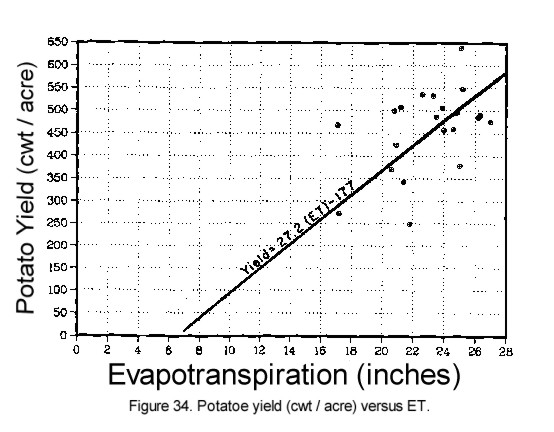Potatoes
Water Production Function
New Mexico Crop Information Potato Water Production function or the relationship between Evapotranspiration and yield Et = evapotranspiration or water used by crop.

y = 27.2Et - 177 where y is cwt/acre and Et is inches.
The reference for this work is Boman, B. 1983. Consumptive use on the Navajo Indian Irrigation Project. Bureau of Reclamation Engineering and Research Center Denver, Colorado Cosati field /group: 02c. Cowrr: 0203, 0203.1
Best Management Practices (BMP)
For growing Potatoes in Farmington New Mexico
Dan Smeal - Date 12/12/2000
Potatoes are selected for their cooking qualities. Chipping cultivars, such as Atlantic or Norchip are generally fried and used for French fries or potato chips. Russet (ie. Burbank or Norkotah) and red potatoes (ie. Sangre or Pontiac) are usually boiled or baked. The skins of chippers are thin and usually white in color. Russet potatoes have a thicker, usually brown-colored skin. The tables below show the yields of some potato varieties that have been grown in test trials at the Agricultural Science Center (ASC), Farmington. Many other varieties are patented and unavailable for general use.
In the Farmington area, potatoes are usually planted between April 15 and April 30 when irrigation water is available. Seed pieces (size) are planted at a 6-inch spacing in 34-inch beds at a depth of 6 inches with a potato planter. Prior to planting, the soil is plowed, disked and listed to form furrows between raised beds. Dry fertilizer at rates of 50 lb N, 150 lb P2O5, 100 lb K2O and 20 lb zinc sulfate per acre is broadcast to the field prior to disking or listing. After plant establishment, N fertilizer is applied weekly to the crop at a rate of 10 lbs N/acre. This is accomplished by injecting liquid N (ie. 32-0-0) through the sprinkler irrigation water. If facilities are not available for injection of nitrogen into the sprinkler system, all of the N (about 150 to 200 lbs N/acre) can be applied dry and incorporated into the soil prior to planting.
To control weeds, a metolachlor (Dual) plus metribuzin (Lexone or Sencor) mixture (ie. Turbo) is sprayed on the soil surface after planting but just prior to potato emergence at the labeled rates. The herbicides are incorporated into the soil surface through a light sprinkler irrigation (1/4 inch) or cultivation.
Depending upon soil moisture conditions at planting, irrigations are applied sparingly prior to plant emergence to avoid rotting of the seed piece. After emergence, irrigations are scheduled to provide plant water requirements based on the irrigation scheduling water balance model for potatoes. See NM Weather.
Late blight may become a disease problem from early July through harvest. It is characterized by non- vigorous plants with round, brown rings on the leaves. It is controlled by spraying the foliage with a recommended fungicide at the labeled rates. Refer to the crop protection reference
Depending on cultivar, potatoes will be ready for harvest between mid-September mid-October. When the tubers are mature, the skins will "set" (ie. they will not peel off easily with slight pressure from thumbnail). Maturity occurs from late August to late September, depending on cultivar. When the skin has set, irrigations can be withheld and the potato vines can be allowed to dry naturally or sprayed with a defoliant to hasten drying. After the vines have dried, they should be mowed prior to harvest with a potato digger.
Store harvested potatoes in a cool (45-55 F), dry environment.
Table 1 Fresh Pack trial study results at Farmington NM.